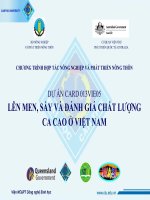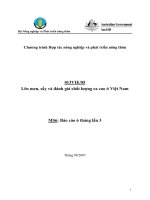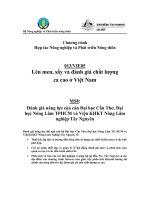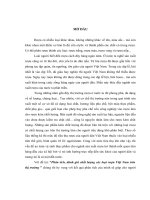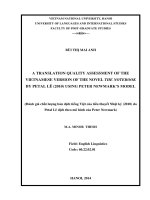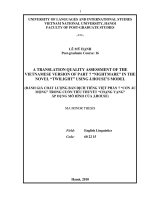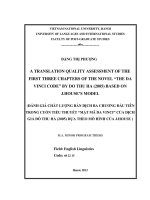Đánh giá chất lượng bản dịch Tiếng Việt tác phẩm “Chicken Soup for Mother and Daughter Soul” áp dụng mô hình của Julliane House= evaluating the vietnamese version of the book chicken soup for mother and daughter soul by jack candfield and mark victor has
Bạn đang xem bản rút gọn của tài liệu. Xem và tải ngay bản đầy đủ của tài liệu tại đây (636.36 KB, 62 trang )
VIETNAM NATIONAL UNIVERSITY, HA NOI
UNIVERSITY OF LANGUAGES AND INTERNATIONAL STUDIES
FACULTY OF POST-GRADUATE STUDIES
***
NGUYỄN THỊ BÍCH HẠNH
EVALUATING THE VIETNAMESE VERSION OF
THE BOOK ‘CHICKEN SOUP FOR MOTHER AND
DAUGHTER SOUL’ BY JACK CANDFIELD AND MARK
VICTOR HASEN USING JULLIANE HOUSE’S MODEL
(Đánh giá chất lượng bản dịch Tiếng Việt tác phẩm “Chicken Soup
for Mother and Daughter Soul” áp dụng mô hình của Julliane House)
M.A MINOR THESIS
Field: English Linguistics
Code: 60 22 15
Hanoi - 2013
VIETNAM NATIONAL UNIVERSITY, HA NOI
UNIVERSITY OF LANGUAGES AND INTERNATIONAL STUDIES
FACULTY OF POST-GRADUATE STUDIES
***
NGUYỄN THỊ BÍCH HẠNH
EVALUATING THE VIETNAMESE VERSION OF
THE BOOK ‘CHICKEN SOUP FOR MOTHER AND
DAUGHTER SOUL’ BY JACK CANDFIELD AND MARK
VICTOR HASEN USING JULLIANE HOUSE’S MODEL
(Đánh giá chất lượng bản dịch Tiếng Việt tác phẩm “Chicken Soup
for Mother and Daughter Soul” áp dụng mô hình của Julliane House)
M.A MINOR THESIS
Field: English Linguistics
Code: 60 22 15
Supervisor: Assoc.Prof.Dr. LÊ HÙNG TIẾN
Hanoi - 2013
iv
TABLE OF CONTENTS
Page
Declaration i
Acknowledgement ii
Abstract iii
Table of contents iv
List of abbreviations vi
List of figures vii
A. INTRODUCTION
1. Rationale for the study 1
2. Significance of the study 1
3. Scope and objectives of the study 3
3.1. Scope of the study 2
3.2. Research questions 2
4. Research methods 2
5. Organization of the study 2
B. DEVELOPMENT
CHAPTER I. LITERATURE REVIEW 3
1. Translation theory 3
1.1. Definitions of translation 3
1.2. Translation methods and strategies 5
1.3. Translation equivalence 10
1.4. Translation quality assessment 13
2. Literary translation 15
2.1. Characteristics of literary translation 16
2.2. Challenges in literary translation 17
3. Introduction about the book 18
CHAPTER 2. APPLICATION OF HOUSE’S MODEL FOR TRANSLATION
QUALITY ASSESSMENT 21
v
1. Presentation of the model 21
1.1. An overview of the model 21
1.2. Operation of the model 22
2. Application of the model 26
2.1. Analysis of the source texts 26
2.2. Statement of function 32
CHAPTER 3. DISCUSSION 34
1. Comparison of Target Text and Source Text 34
1.1. Medium 34
1.2. Participation 37
1.3. Social role relationship 37
1.4. Social attitude 38
1.5. Overtly erroneous errors 39
2. Statement of quality 41
C. CONCLUSION
1. Conclusion 42
2. Implications for translating English literary works into Vietnamese 43
3. Suggestions for further research 44
REFERENCES 45
APPENDICES I – XI
APPENDIX I. Placing of clauses and expressions of purpose and time before the
main clauses I
APPENDIX II. Use of parenthetical and appositional structures III
APPENDIX III. Spoken language signals or interjections V
APPENDIX IV. Presence of connectors VI
APPENDIX V. Presence of reference VII
APPENDIX VI. Repeated structures IX
APPENDIX VII. Noun and noun phrases are translated into clauses XI
vi
LIST OF ABBREVIATIONS
SL: Source Language
TL: Target Language
ST: Source Text
TT: Translation Text
vii
LIST OF FIGURES
Figure 1: Translation Process Page 6
Figure 2: A Scheme for Analyzing and Comparing Original and Translation Texts
Page 24
1
A. INTRODUCTION
1. Rationale for the study
In the trend of globalization and integration, people are more frequent to read
books and documents written in a foreign language because that helps them to
understand and be more familiar with the thoughts, traditions, principles and actions
of the people from the culture. Therefore, translation is regarded as a significant key
interlinking people from all cultures in the world. In Vietnam, more and more
foreign books and documents are translated into Vietnamese. However, Vietnamese
readers do not always have chance to approach translations of good quality and that
a translation is considered good still draws much discussion. Each translation
theorists has his or her own founded criteria for translation quality assessment.
Among distinguished scholars of this field is Julian House who is a German
linguist, with her model for translation quality assessment.
Many famous English books have been translated into Vietnamese. „Chicken
Soup for Mother and Daughter Soul‟ by Mark Victor Hansen and Jack Canfield is
one of them. Being translated into Vietnamese, the series of the book are popular to
a number of Vietnamese readers. Nevertheless, as mentioned above, translating a
foreign text and making it acceptable by the target language readers is not easy due
to the fact that each language has its own unique features and peculiarities and
literary book translation calls for stringent and high quality standards. Therefore, an
assessment of the Vietnamese version of this book is thus desirable.
2. Significance of the study
The results of the study will be used as suggestions and references to analyze
and evaluate the quality of other literary translated works. Also, the research results
will be used as guidelines for conducting further research in translation and in other
related fields. Besides, the study will also propose some suggestions concerning the
translation of English literary works into Vietnamese.
2
3. Scope and objectives of the study
3.1. Scope of the study
The book series „Chicken Soup for the Soul‟ consists of almost 200 titles in
print and a study of the whole book series is therefore beyond the scope of this
paper. So, the study will analyze volume 9 of the series which is entitled “Mother
and Daughter Soul” translated by Ngoc Diep and Vi Thao Nguyen.
3.2. Research questions
The study aims at finding answers to two questions:
1. How good is the translation according to House‟s model?
2. What are the remaining problems of the translation?
4. Research methods
The paper aims at assessing the quality of the Vietnamese translation of the
book „Chicken Soup for Mother and Daughter Soul‟ by Mark Victor Hansen and
Jack Canfield. To achieve that aim, a set of criteria for assessment is essential.
House‟s model is chosen to apply in this study because of comprehensive set of
parameters for assessing functional and pragmatic equivalence of the translation
text.
Applying House‟s model, the researcher follows the chronological steps in
translation quality assessment suggested by House. Firstly, a source text (ST) is
selected, and then a register analysis is done to get the source text profile based in
the eight situational dimensions. A statement of function of the ST will be made
after that. Next, a profile of the translation text will be come up with and compared
with the ST‟s to find out mismatches before a statement of quality can be drawn
about the target text (TT).
5. Organization of the study
The study contains three chapters:
3
Chapter 1 – Literature Review
In this first chapter, some related concepts of translation theory and typical
models of translation quality assessment are introduced. Also, the chapter discusses
characteristics and challenges of literary translation.
Chapter 2 – Application of House‟s model for translation quality assessment
In this chapter, House‟s model for translation quality assessment will first be
presented and then applied to analyze and decide the ST profile as well as statement
of function with ideational and interpersonal meaning.
Chapter 3 – Discussion of results and implications
In the third chapter, the researcher will apply Julliane House‟s model to
analyze and compare the English ST and the Vietnamese translation one and then
draw the statement of quality.
4
B. DEVELOPMENT
CHAPTER I – LITERATURE REVIEW
1. Translation theory
1.1. Definitions of translation
To translate is understood as to express the meaning of speech or writing in a
different language. However, in translation studies, things are not that simple.
Theorists approached translation studies differently and they proposed various
definitions of translation.
Catford (1965:20) defined translation as “the replacement of textual material
in one language (source language – SL) by equivalent textual in another language
(target language – TL)” (Catford, 1965). Also basing on the concept of equivalence,
Nida and Taber (1982) suggested that “translation consists of reproducing in the
receptor language the closest natural equivalence of the SL message, first in terms
of meaning and secondly in terms of style” (Nida and Taber. 1982). The definitions
are not limited only on Catford and Nida and Taber‟s point of view. There are
several definitions stated by some experts.
Discussing three aspects of meaning which are semantic, pragmatic and
textual, House (1977:29) introduced a tentative definition of translation.
“Translation is the replacement of text in the SL by a semantically and
pragmatically equivalent text in the TL” and these are only written texts. Similarly,
Wilss (1982) focused on written text and he considered translation a procedure
which leads from a written SL text to an optimally equivalent TL text, and which
requires the syntactic, semantic, stylistic, and text pragmatic comprehension by the
translator of the original text. In Bell‟s definition (1991), three aspects of
translations are also mentioned. He defined that translating is the transformation of
a text originally in one language into an equivalent text in a different language
retaining, as far as possible, the context of message, the formal features and the
roles of the original text.
5
Some other scholars approve the idea that translation deals with the meaning.
Translation with the correct structure is useless without the meaning. In Dubois‟s
point of view, translation is the expression in another language (or TL) of what has
been expressed in another (SL), preserving semantic and stylistic in equivalences
(Dubois, 1973 cited in Bell, 1991). It means that translation has to be able to say the
expression in TL as well as it is said in the SL. The translated language version
should give the same meaning on the TL when it is compared to the SL. Newmark
stated a further view towards the transferring meaning in a translation. As he says
(1988:5), translation is rendering the meaning of a text into another language in the
way that the author intended in the text.
Unlike previous scholars, Hatim and Mason (1990) suggested that translating
is a communicative process which takes place within a social context (Hatim and
Mason, 1990:3). Translation deals with the signs and attempts to preserve semiotic
as well as other pragmatic and communicative properties which signs display.
No matter how diversely the scholars defined translation, the basic ideas they
shared are that translation does not deal with language as a system, but with
language in use and that the essence of translation lies in the preservation of
semantic, pragmatic, and textual aspects of meaning across two different languages.
1.2. Translation methods and strategies
Nida (1969) in Munday (2001:40) divide the process of translating into three
stages system: (1) analysis of message in the SL; (2) transfer; (3) reconstruction of
the transferred message in the TL.
6
Figure 1: Translation Process
As can be seen from the diagram, ST is analyzed in terms of the intention of
the text, the intention of the translator, text styles, the readership, stylistic scales,
attitude, setting, the quality of the writing, connotations and denotations, and the
cultural aspect of the text. Then the meaning is transferred from the SL to the TL.
The last stage is the reconstruction stage in which the translator revises or re-
expresses the materials in such a way that the translation product is readable and
acceptable in terms of rules and styles in the TL.
1.2.1. Translation methods
There have been various classifications of translation methods introduced by
different scholars such as Darbelnet (1973), Larson (1984), Newmark (1988),
Delisle (1999), etc. In this part, the classification by Newmark (1988) is presented
because it is more detailed and systematic.
In Newmark‟s point of view, translation methods can be categorized into two
groups which are semantic translation and communicative translation. Semantic
translation follows the form of the SL whereas communicative translation
communicates the meaning of the SL text in the natural forms of the TL. He
introduced the V-diagram of translation methods.
A (Source Language)
B (Receptor Language)
Analysis
Restructuring
Transfer
X
Y
7
(Newmark, 1988: 45)
Newmark briefly explained these methods as:
- Word-for-word translation: The SL word-order is preserved and words
translated singly by their most common meaning, out of context. This method is
used to understand the mechanics of SL or to explain a difficult text as a pre-
translation process.
- Literal translation: The SL grammatical constructions are converted to
their nearest TL equivalents but the lexical words are translated singly, out of
context. It is used to translate general styles texts with few cultural differences such
as manuals, news, etc. It is also called borrowing translation.
- Faithful translation: The translator attempts to reproduce the precise
contextual meaning of the original within the constraints of the TL grammatical
structures. Cultural words are transferred but the degree of grammatical and lexical
abnormality is maintained in the translation.
- Semantic translation: This translation method is closer to the TL than
other method in the semantic group. It takes more account of the aesthetic value of
the SL text and does not rely on cultural equivalence and make small concessions to
the readership. Therefore, it is more flexible, allows for the translator‟s intuitive
empathy with the original.
8
- Communicative translation: The translation units dealt with are word,
paragraph, and text. The translator attempts to render exact contextual meaning of
the original. Both the content and the language are readily acceptable and
comprehensible to the reader.
- Idiomatic translation: This method deals with translation unit of sentence
and paragraph. It reproduces the „message‟ of the original but tends to distort
nuances of meaning by preferring colloquialisms and idioms where these do not
exist in the original. The outcome is a lively and natural translation.
- Free translation: It is used for translation unit of sentence and paragraph.
This method reproduces the matter without the manner and the content without the
form of the original. It is usually a paraphrase so the translation is much longer than
the original.
- Adaptation: The method is the freest form of translation and deals with
text unit. It is mainly used for plays, poetry, and songs. In adaptation, the themes,
characters, plots are preserved, and the SL culture is converted to the TL culture and
the text is rewritten.
(Newmark, 1988: 45-7)
1.2.2. Translation procedures
While translation methods relate to the whole texts, translation procedures
are used for sentences and smaller units of language. After a translation method has
been selected, the actual work of translating can be conducted. To achieve the goal
of transferring the text from the SL into the TL, the translator will have to combine
several of the following translation procedures proposed by Newmark (1988b):
- Transference: it is the procedure of deciding use an SL word in his TL text
because there is no appropriate term. This procedure is used in certain situations
such as names of all living and dead people, geographical and topographical names,
9
names of periodicals and newspapers, titles of literary works, plays, and films,
names of companies and institutions, street names, and addresses, etc.
- Naturalization: It adapts the SL word first to the normal pronunciation,
then to the normal morphology of the TL.
- Cultural equivalent: It is called an approximate translation where an SL
cultural word is translated by a TL cultural word. This procedure is used when a
brief explanation to readers who are ignorant of the relevant SL culture is needed.
- Functional equivalent: It is applied to culture words and requires the use
of a culture-free word, sometimes with a new specific term. It, therefore,
neutralizes or generalizes the SL word. This procedure, which is a cultural
componential analysis, is the most accurate way of translating.
- Descriptive equivalent: In this procedure the meaning of the original
word is explained in several TL words. It is often used with transference to translate
a cultural word or expression.
- Componential analysis: It means "comparing an SL word with a TL
word which has a similar meaning but is not an obvious one-to-one equivalent, by
demonstrating first their common and then their differing sense components."
- Synonymy: It is a "near TL equivalent." Here economy trumps accuracy.
- Through-translation: it is the literal translation of common collocations,
names of organizations, components of compounds and perhaps phrases. It is used
for already recognized terms. It is also called calque or loan translation.
- Shifts or transpositions: It involves a change in the grammar from SL to
TL, for instance, (i) change from singular to plural, (ii) the change required when a
specific SL structure does not exist in the TL, (iii) change of an SL verb to a TL
word, change of an SL noun group to a TL noun and so forth. It is used when a SL
grammatical structure does not exist in the TL or where literal translation is
grammatically possible but may not accord with natural usage in the TL.
10
- Modulation: It is a variation in the message when it is translated into a TL
due to a change in the point of view. It occurs when the translator reproduces the
message of the original text in the TL text in conformity with the current norms of
the TL, since the SL and the TL may appear dissimilar in terms of perspective.
- Recognized translation: it occurs when the translator "normally uses the
official or the generally accepted translation of any institutional term."
- Compensation: it occurs when loss of meaning in one part of a sentence
is compensated in another part.
- Paraphrase: in this procedure the meaning of the CBT is explained. Here
the explanation is much more detailed than that of descriptive equivalent
- Couplets: it occurs when the translator combines two different procedures
to deal with a single problem. It is common for cultural words, where transference
may be combined with a functional or cultural equivalent.
- Notes: notes are additional information in a translation.
1.3. Translation equivalence
Translation equivalence is the central issue in translation theory. It is the
relationship between a SL text and a TL text (rather than between the languages
themselves) that allows the TL text to be considered as a translation of the SL text.
As Catford points out, "the central problem of translation-practice is that of finding
TL equivalents. A central task of translation theory is that of defining the nature and
conditions of translation equivalence." (Catford, 1965: 21). So, equivalence is the
main criterion in assessing the quality of a translation. A translation is generally
said to be good if it can maintain a certain degree of equivalence to ST. The
following are some elaborate approaches to translation equivalence.
1.3.1. Jakobson (1959): linguistic meaning and equivalence
According to Jakobson (1959), equivalence is always possible (regardless of
the cultural or grammatical differences between ST and TT). He suggests three
11
kinds of translation, which are intralingual (within one language, i.e. rewording or
paraphrase), interlingual (between two languages), and intersemiotic (between sign
systems).
In his point of view, in the case of intralingual translation, synonyms are
used to get ST message across. In other words, in this type of translation, full
equivalence between unit codes does not exist. He also claims that from a
grammatical point of view languages may differ from one another to a greater or
lesser degree, but this does not mean that a translation cannot be possible and that
the translator may face the problem of not finding a translation equivalent. So,
“whenever there is deficiency, terminology may be qualified and amplified by
loanwords or loan-translations, neologisms or semantic shifts, and finally, by
circumlocutions” (Jakobson, 1959 cited in Luong (2007)).
1.3.2. Nida and Taber (1982): Dynamic equivalence and formal
equivalence
Nida (1964) claims that equivalence is categorized into two different kinds –
formal equivalence and dynamic equivalence. Later formal equivalence is referred
to formal correspondence by Nida and Tiber (1982). In formal correspondence, the
message in the TL should be conveyed by elements that are as closely matching as
possible with those in the SL. Meanwhile dynamic equivalence is defined as a
translation principle according to which a translator seeks to translate the meaning
of the original in such a way that the TL wording will trigger the same impact on
the TC audience as the original wording did upon ST audience (Nida and Tiber
(1982)). A translation, in their opinion, is successful if it can achieve equivalent
response in the two languages, which means dynamic equivalence is the goal of
translation.
1.3.3. Koller (1989): five types of equivalence
12
Koller (1989) establishes translation equivalence categories which involve
various types of equivalence among which are denotative, connotative, text-
normative, pragmatic, and formal equivalence.
- Denotative equivalence:
Denotative equivalence is the type of equivalence in which the SL and TL
words are supposedly referred to the same thing in the real world. This type of
equivalence is related to the equivalence of the extra linguistic content of a text. It is
also the purpose of any translation procedure, which is to find the referential
identity between SL and TL units.
- Connotative equivalence:
Connotative equivalence is realized when the SL and TL words trigger the
same or similar associations or communicative values in the mind of native
speakers of the SL and TL. It is related to the lexical choices, especially between
near-synonyms.
- Text-normative equivalence:
When the SL and TL words are used in the same or similar text types in their
respective languages, it is called text-normative equivalence.
- Pragmatic equivalence:
Pragmatic equivalence is oriented towards the receiver of the text or
message. This type of equivalence is established to translate the text for a particular
readership. The expectations of the target readers have to be considered. Pragmatic
equivalence is also used when the translator wants to make an impact on the
readers.
- Formal equivalence:
13
Formal equivalence is related to the form and aesthetics of the text, includes
word plays and individual stylistic features of the source text. It is particularly used
in translation of poems, songs, etc.
1.3.4. Baker (1992): Form-based equivalence
In Baker‟s theory of translation equivalence, she combines both linguistic
and communicative approach. The notion of equivalence at different levels is
explored in relation to the translation process.
- Equivalence at word level and above word level: when translating from
one language into another.
- Grammatical equivalence: when referring to the diversity of grammatical
categories across languages.
- Textual equivalence: when referring to the equivalence between a SL text
and a TL text in terms of information and cohesion.
- Pragmatic equivalence: when referring to implicatures and strategies of
avoidance during the translation process.
1.4. Translation quality assessment
1.4.1. Definition of translation quality assessment
Translation quality assessment is a type of evaluation which “is taken to
mean the determination of merit, worth, or significance” (Scriven, 2007, p.1, as
cited in Williams, 2009). According to Malcolm William (2009), translation quality
assessment can be quantitative or qualitative, i.e. it can be based on mathematical or
statistical measurement or on reader response, interviews, and questionnaires.
Besides, translation quality assessment can be diagnostic, formative or summative.
It is diagnostic when it is used to determine areas for improvement at the beginning
of a course of study. If it is chosen to measure the progress and give feedback
14
during a course of study, it is formative. When being used to measure the results of
learning, translation quality assessment is summative.
1.4.2. Approaches to translation quality assessment
Translation quality assessment is a controversial issue and is still under-
researched. In this part, the writer would like to present approaches sorted by House
(2001).
Mentalist Views
In mentalist views, the evaluation of a translation is subjective and intuitive.
Although this view was propagated, House dismisses it by claiming that texts have
no core meanings and their meanings change depending on individual speakers‟
positions.
Response-based Approaches
In behavioristic views, the translator‟s mental actions are dismissed. Instead
of that, a more scientific way of evaluating translations is chosen. Nida (1964) is the
most famous pioneering scholar in this tradition. He took readers‟ reactions to a
translation as the main tool to assess the quality of a translation. However, Julliane
House rejects this approach. She doubts the possibility to measure an equivalent
response. Also, she claims that the source text is largely ignored in this method.
Another approach in response-based approaches is functionalistic, “skopos”-
related approach. Reiss & Vermeer (1984), supporters of this approach, claim that
purpose (skopos) of a text and target culture norms are important to judge a
translation. The translator is the person who decides on the function of the
translation. Nevertheless, House criticizes that the theory does not define clearly the
notion of “function” and this skopos theory cannot be said to be an adequate theory
when it comes to tackling the evaluation of a translation in its fundamental
directionality.
15
Text and Discourse Based Approaches
In literature-oriented approach, a translation is evaluated mainly in terms of
its forms and functions inside the system of the receiving culture and literature
(Toury, 1995). In other words, the main focus in this approach is the actual
translation and the textual phenomena that have come to be known in the target
culture as translations. Nonetheless, as in House‟s criticism, this focus is
particularly inappropriate to make valid statements about how and why a translation
is as it is. Moreover, the approach does not provide criteria to judge strengths and
weaknesses of a particular case or a given translation text.
Scholars belonging to post-modernist and deconstructionist thinking
(Venuty, 1995 and Robinson, 1997) review translation practices from a psycho-
philosophical and socio-political view in order to reveal unequal power relations.
House (2001) indicates that in this approach it is difficult to in differentiate the
source text and the target text.
For linguistically-oriented approaches, there are a number of adherents,
namely Catford (1965), the early Reiss (1971), Wilss (1974), Koller (1979), Baker
(1992), Doherty (1993), Hatim and Mason (1997), Hickey (1998), Gerzymisch-
Arbogast and Mudersbach (1998) and Steiner. The approaches consider the
relationship between source and translation text serious, but they are different in the
capacity to provide detailed procedures for analysis and evaluation. So, the
auspicious approaches are the ones which explicitly take into consideration the
interconnectedness of context and text.
A Functional-Pragmatic Model of Translation Evaluation
The assessment model (House, 1997), an analytic framework for analyzing
and comparing original and translation texts is based on Halliday systemic-
functional theory and also uses Prague school ideas, speech act theory, pragmatics,
discourse analysis and corpus-based distinctions between spoken and written
16
language. In this model, House stresses the importance of a cultural filter in
particular types of translation. Moreover, she provides for the analysis and
comparison of an original and its translation on three different levels: the levels of
language or text, register (field, mode and tenor) and genre.
2. Literary translation
2.1. Characteristics of literary translation
Literary texts include all forms of literature written in prose or poetry. They
can be a short story, a novel, a drama, etc. According to Reiss (1989), literary texts
belong to expressive text type in which the authors use the aesthetic dimension of
language. In literary translation, the typical features of the source literary text not
only need to be considered carefully but also are the influential elements. In Jone‟s
(2009) summary of a wide range of viewpoints from Stockwell (2002), Venuti
(1996), Pilkington (2000), and Berman (2000), a set of typical features of literary
text are indicated. As in the scholars‟ viewpoints, literary texts are in written-form,
although sometimes they can be spoken. Besides, they fulfill affective or aesthetic
function rather than transactional or informational function. They focus on the
expression of emotions and entertain rather than influence or giving information.
Moreover, they are considered to be fictional. Whether being fact-based or not, they
features words, images, etc. with ambiguous or indeterminable meanings. Last but
not least, they are characterized by poetic language use.
Recognizing the characteristics in a literary text will enable the translator to
be at least partly qualified to fulfill his task with much more accuracy. The first
characteristic of literary translation is rhetorical and aesthetic value which
distinguishes a literary text from a non-literary one and is the essence expected to be
captured and maintained in a literary translation. Literary works are created
artistically by increasing the difficulty and length of perception, which leads to
defamiliarization (Shklovsky, 1917, quoted in Pilkington, 2000: 18). Once the
defamiliarization is comprehended by the translators or readers, a unique sensation
17
is created. Moreover, in literary translation, the form connects with the content
meanwhile in non-literary translation the content may be considered detachable
from the form or structure. In poetry, devices such as assonance, alliteration,
onomatopoeia, rhythm, verse, metre, and rhyme are sometimes used to achieve
musical or incantatory effects. Likewise, in prose a certain linguistic feature or level
can also have a certain textual function. Another characteristic of literary translation
is that literary translators‟ choices of wording highly depend on the TL and target
culture. Therefore, literal translation may be unacceptable because of linguistic or
cultural differences. What‟s more, in literary translation, target audiences are taken
into consideration. Literary translation always has a readership which is likely to be
quite different from the one the writer originally had in mind. So, a good translation
of any text from any period will, to some extent, only be good in the context of a
particular audience at a particular time and place. Finally, there is no definite correct
translation in literary translation. However, there is still a proper or an appropriate
translation according to certain criteria or from a certain perspective.
2.2. Challenges in literary translation
Literary translation is challenging to any translators due to special
characteristic of literary texts. The first challenge of literary translation lies in the
differences between cultures. Literary translation bridges the delicate emotional
connections between cultures and languages and furthers the understanding of
human beings across national borders. In the act of literary translation, the soul of
another culture becomes transparent, and the translator recreates the refined
sensibilities of foreign countries and their people through the linguistic, musical,
rhythmic, and visual possibilities of the new language. In the process of translating
literary texts, there are problems in the translation of cultural words in a literary text
due to the cultural gaps between the SL and the TL. It is not enough for a translator
to know what words are used in the TL. He must also make the reader understand
the sense as it is understood by the reader of the SL.
18
Another problem of literary translation belongs to the the process of finding
equivalents not just for lexis, syntax or concepts but also features likes style, genre,
figurative language, historical stylistic dimensions, etc. Therefore, the translator‟s
choices whether to retain stylistic features of the SL text or historical stylistic
dimension are important. For example, when translating poetry, it is vital for the
translator to decide whether the verse should be translated into verse, or into free
verse or into prose.
Moreover, poetic language is non-standard so the translation is under the risk
of being unfamiliar. Bassnett points out that “Again and again, translators of novels
take pains to create readable TL texts, avoiding ST effect that can follow from
adhering too closely to source language syntactical structures, but fail to consider
the way in which individual sentences form part of the total structure” (Bassnett,
2002: 115). She then suggests that “what the translator must do, therefore, is to first
determine the function of the SL system and then to find a TL system that will
adequately render the function” (Bassnett, 2002: 199), which shows her view of
giving priority to the aesthetic function. Determining the function of the source
language requires the translators‟ knowledge of ST, which guides the translators to
“consider the way in which individual sentences form part of the total structure”
(Bassnett, 2002: 115).
3. Introduction of the book
„Chicken Soup for the Soul‟ is the name of a series of books with collections
of short and dense inspirational stories and motivational essay. The first stories of
the series were compiled by two internationally known speakers, Jack Canfield and
Mark Victor Hansen.
Jack Canfield and Mark Victor Hansen had been known as two famous
speakers telling inspirational and motivational stories which could be used for their
audiences to discover, experience, and retain their key concepts and approaches.
Their audiences‟ requests to have stories in the written form were finally responded
19
to after many years. Rather than focusing on their stories only, Hasen and Canfield
decided to add other people‟s stories and search for stories of ordinary people doing
extraordinary things. After finding and gathering the 101 most inspirational
submissions, they were in the process of thinking of a winning title and they
decided to meditate in the subject one hour a day. The idea of the name Chicken
Soup for the Soul came when Jack imagined the image of his grandmother‟s chicken
soup and how she told him it would cure anything. Having the same power as the
soup, however, the book is for the soul, not the body. So, the famous title was born.
On June 28
th
, 1993 the book was made available to the public and only by
the end of December, it became a holiday favorite. The success of the first book
also launched the series. There have been more than 200 titles until now. Many of
the books are directed at specific groups of people, such as Chicken Soup for the
Mother's Soul, Chicken Soup for the Preteen Soul, Chicken Soup for the Prisoner's
Soul, Chicken Soup for the Soul: Tough Times, Tough People, Chicken Soup for the
Grandparent's Soul, Chicken Soup for the Soul: Teens Talk Relationships, and
Chicken Soup for the Soul: Thanks Dad, etc. By September of 1994 it was also on
the best seller list in the U.S and Canada.
With meaningful inspirational stories, it did not take long for the series to
start receiving industry awards and recognition. In 1995, Chicken Soup for the Soul
won the American Booksellers‟ Book of the Year – a prestigious award. Next, in
1996, it was given the Non-Fiction Literary Award by the American Family
Institute. In 1998, Chicken Soup for the Soul for the Kid‟s Soul was voted Favorite
Book of the Year for Nickelodeon‟s Kid‟s Choice Awards. In that same year Chicken
Soup for the Soul set a record for having seven books on the New York Times
bestseller list at one time and launched its licensing program, which allows the life
improvement brand to reach people in a variety of formats. In 2008, for the fact that
the digital age would enable Chicken Soup for the Soul to impact lives on a far
greater scale, Jack and Mark reached the decision that they would add multimedia
expertise to their company. In April of 2008 they sold a significant stake in Chicken


